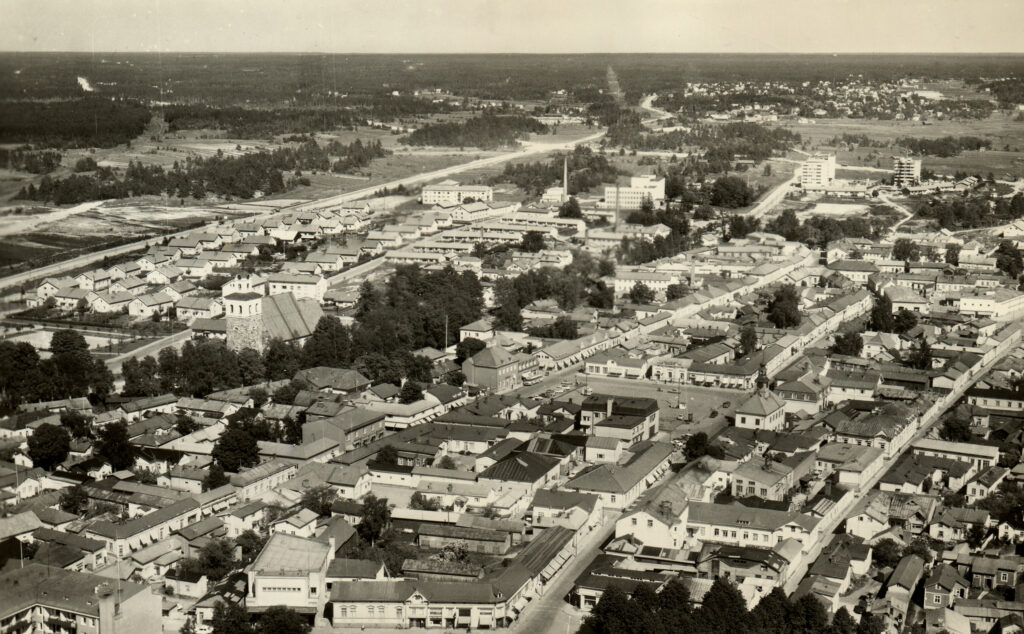Krann
Pappilankatu 2
Property code: 001-162-236

History
There were two plots in Krann in 1756. One was owned by Juhana and the other by Maria Wahlbeck. In 1800, plot 236 was owned by the estate of the bourgeois Wahlberg widow. The property also included three barrels of arable land, a meadow, a granary and a barn.
Modification drafts
From 1889, John Fredr. Lindegren’s alteration drawing of a building in the eastern half of the plot, near the eastern boundary, with the end facing the Rauma River. The building had been a one-room building, but now they wanted to extend it with a bakery and a room, and to make a porch in front of the entrance. The baking room was placed in the middle with a large room on either side. The building was given a neo-renaissance lining. The façade is tripartite, and the four-light windows have moulded mouldings. The porch has a hipped roof.
In 1899, the residential building along Vähäkoulukatu was converted. The plans were drawn up by Arvi Forsman. The bakehouse and pantry at the eastern end of the building belonged to one owner, while the bakehouse and pantry at the western end, the building-wide living room, hallway and anteroom belonged to another owner. The alterations were to the west end. The wall between the bakehouse and the chamber was moved to make the chamber larger. The hallway was turned into a kitchen and the tiled stove in one room was moved to the kitchen stove, in the middle of the building. The other ovens remained in their old positions on the outside walls. The porch in front of the former hallway was demolished and replaced by two new ones. There were three entrances to this half of the building, so the space could be rented out.
In 1908, changes were made to the buildings on the site. The plans were drawn up by Leonard Ahti. The residential building on Vähäkoulukatu was extended on the courtyard side. Two new kitchens, a pantry and two hallways were added to the extension. The old part of the building was converted into four living rooms. Three apartments were created, one of which had three rooms, a kitchen and a hallway, and a separate main entrance and kitchen entrance. The second apartment had a room, a kitchen and a hallway. The third apartment had a room with its own entrance. A heating oven was installed in the room, with a cooking hob with rings behind the hatches. All the fireplaces were replaced. The baking ovens were no longer made. The outbuilding had a barn, a latrine and two storage rooms. Now a small additional room was built on the side of the building on the courtyard side using board.
The residential building received a new lining. The lower part is horizontal boarded and the attic part is vertical boarded. The framing of the T-shaped windows is in the Art Nouveau style. The upper moulding is topped by a strong detached triangular subject. The river-facing façade is rendered in horizontal boarding and the attic in vertical boarding. The façade is structured by vertical mouldings. The gateway to the property also has Art Nouveau influences.
In 1913, changes were made to the outbuilding on the riverbank. The plan was drawn up by Arvi Leikari. A couple of new rooms were added to the wing facing Pappilankatu and the previous extension was demolished.
In 1972, changes were planned. The aim was to make the gate similar to the one designed by Leonard Ahti, with a top beam and a latticed top. The street-side building would continue to have three apartments. The small building facing the river would retain one apartment. All the apartments would be modernised, equipped with toilets and showers and modern kitchens. The furnaces would be dismantled and the ceilings would be lowered. The outbuilding would include a boiler room and sauna, as well as a carport. Narrow windows would be opened on the river side. However, the alterations were postponed, and new plans for the interior date from 1975. The lowering of the roofs was abandoned. The next time the alterations, which were subject to planning permission, were made was in 1978. This was a change to the carport. In 1991, internal alterations were made. One room was moved from one flat to another and the location of one kitchen was changed.
Current situation
Residential building along the street
A short-cornered residential building, vertically boarded, with a saddle roof. the Art Nouveau lining was designed by Leonard Ahti in 1908.
Residential building in the yard
Residential building, Neo-Renaissance 1889 (John F. Lindegren)
Outdoor building
Exterior building with horizontal reinforcement
Gate
An old-style gate.